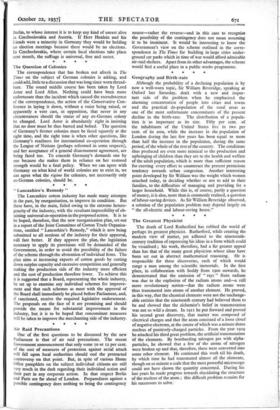* * * * Geography and Birth-rate Although the probability
of a declining population is by now a well-worn topic, Sir William Beveridge, speaking at Oxford last Saturday, dealt with a new and impor- tant side of the problem when he emphasised the alarming concentration of people into cities and towns and the practical de-population of the rural areas as one of the most unfortunate concomitants of the present decline in the birth-rate. The distribution of a popula- tion is as important as its size. Fifty per cent. of the inhabitants of the United States live in two per cent. of its area, while the increase in the population of London during the last few years has been equal to more than half the increase in the population, during the same period, of the whole of the rest of the country. The conditions thus produced are even more inimical to the production and upbringing of children than they are to the health and welfare of the adult population, which is more than sufficient reason for exerting every effort to counteract the present pernicious tendency towards urban congestion. Another interesting point developed by Sir William was the weight which women attached today, in deciding whether or not to add to their families, to the difficulties of managing and providing for a larger household. While this is, of course, partly a question of money, it is also, more than is commonly realised, a question of labour-saving devices. As Sir William Beveridge observed, a solution of the population problem may depend largely on " the all-electric and labour-saving house."






























































 Previous page
Previous page